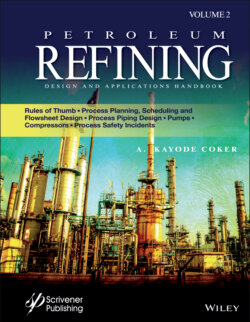Читать книгу Petroleum Refining Design and Applications Handbook - A. Kayode Coker - Страница 37
SIZE SEPARATION OF PARTICLES
Оглавление1 1. Grizzlies that are constructed of parallel bars at appropriate spacings are used to remove products larger than 50 mm in diameter.
2 2. Revolving cylindrical screens rotate at 15–20 rpm and below the critical velocity; they are suitable for wet or dry screening in the range of 10–60 mm.
3 3. Flat screens are vibrated, shaken, or impacted with bouncing balls. Inclined screens vibrated at 600–7000 strokes/min and are used for down to 38 µm, although capacity drops off sharply below 200 µm. Reciprocating screens operate in the range of 30–1000 strokes/min and handle sizes to 0.25 mm at the higher speeds.
4 4. Rotary sifters operate at 500–600 rpm and are suited to a range of 12 mm–50 µm.
5 5. Air classification is preferred for fine sizes because screens of 150 mesh and finer are fragile and slow.
6 6. Wet classifiers mostly are used to make two product size ranges, oversize and undersize, with a break commonly in the range between 28 and 200 mesh. A rake classifier operates at about 9 strokes/min when making separation at 200 mesh and 32 strokes/min at 28 mesh. Solids content is not critical, and that of the overflow may be 2–20% or more.
7 7. Hydrocyclones handle up to 600 ft3/min and can remove particles in the range of 300–5 µm from dilute suspensions. In one case, a 20-in. diameter unit had a capacity of 1000 gpm with a pressure drop of 5 psi and a cutoff between 50 and 150 µm.
